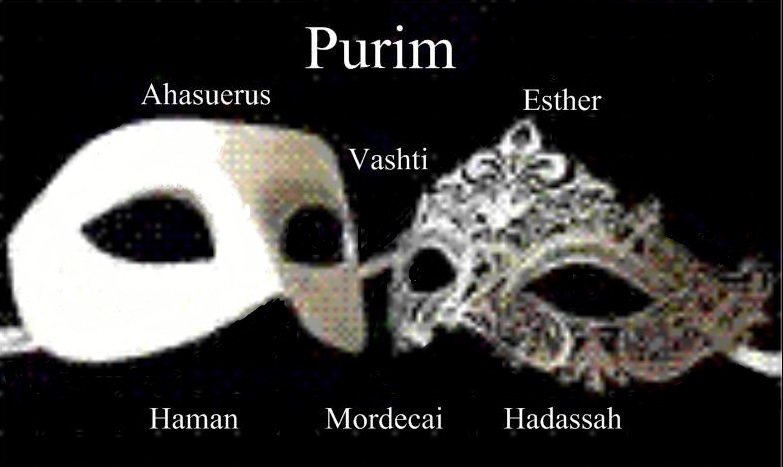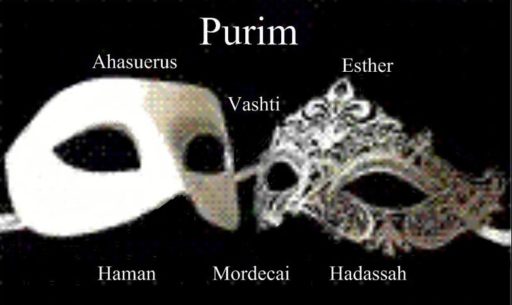COMING SOON!
By Randall E. Pickens, Sr.
The Book of Esther; Is it History, Allegory, Prophecy or “all of the above”? Let’s uncover the answer by examining the “cast of characters“.

The cast and their characteristics reveal hidden truths and the “unmasking” of a Mystery
The name Esther, the person and the Old Testament Book tells the story of the salvation of the Jews in Persia and the origin of the Purim celebration. The name “Esther” is significant in itself because the Hebrew name means “something hidden“. This book has been controversial throughout the ages, in Judaism and Christendom. The mere fact that this story has survived such scrutiny and still remains an important Jewish and Christian literary source in itself is cause for one to desire a better understanding of the mysterious messages and lessons to learn from the account.
I will approach this review by analyzing the individual character’s of this story, and what their personal characteristics and role may represent while considering any prophetic significance. Keep in mind that all the “names” of the characters are historically problematic. It is clear the authors’ intent was to maintain the theme being; a “hidden” meaning while revealing a not only an historic event but prophetic.
The King:
King, Ahasuerus (thought by most to be King Xerxes (c. 519–465 BC), son of Darius I; king of Persia 486–465 BC). The introduction in Esther identifies this King as being in power sometime after the 1st decree of Cyrus and 2nd decree of Darius I to rebuild Jerusalem and the Temple. King Ahasuerus is characterized as being arrogant; he suffered defeat in his attempted conquest of the Greeks, so he chooses to distract attention from his failures by flaunting the wealth and grandeur of his kingdom and its 127 subjugated territories. Preparations for this feast took place over 180 days (6 lunar months). The feast would last 7 days. His 1st Queen Vashti (bride) rejects the Kings command to attend the feast and is deposed and he chooses a 2nd Queen (bride) Esther. The King learns of a plot to assassinate the King from Mordecai via the Queen Esther. The King executes the assassins and promotes Haman the Agagite (Amalekite). When the King honors Mordecai for saving the King, Haman is incensed! The King learns of Haman’s intent to kill Mordecai and orders that Haman meet the very fate that he devised for Mordecai. The King decrees that the Jews be allowed to arm themselves and destroy their enemies. Haman and his 10 sons are hanged on the gallows intended for Mordecai. The Jews are saved only after they reaffirm their “hidden” identity.
Haman:
Haman the son of Hammedatha the Agagite (i.e. Amalekite) is of Arab descent historic enemies of Israel. Haman owes his very existence to the fact that the Israelite’s failed to utterly destroy the Amalekites as commanded. Haman learns that Mordecai is a Jew when he refuses to bow to Haman. Haman is outraged and plots to kill all Jews. Haman is associated with astrology and divination (fortune telling). Haman cast Pur (Purim is the plural form of Pur or lots) for 12 months until settling on Adar 13th for date of execution of the Jews. This would be like rolling the dice! Haman had to wait 11 months before settling on a favorable date (lucky) for enacting the decree he made on the 13th of Nissan; the 1st month of the Jewish ecclesiastic new year. Purim is now celebrated on the 14th of Adar based on these two events (celebrating the day after the date of the original decree and the planed execution date). Haman is hung on the very gallows he built for Mordecai’s execution. Haman’s 10 sons are hung there as well (postmortem). This is thought to be for the purpose of sending a prophetic message to Israel’s future enemies.
Mordecai:
Mordecai is identified as a Benjamite. This associates him with King Saul and the Apostle Paul. The tribe of Benjamin joined with Judah during the divided Kingdom. This would imply that his ancestor (Kish) would have been numbered in the exile of Judah by Nebuchadnezzar.
The name Mordecai has a dual cultural association. It can be associated with Hebrew and Aramaic; the Hebrew meaning is “warrior” and the Aramaic meaning is “follower of Marduk” (a Babylonian God). This would explain how he managed to avoid association with the Jewish nationality/faith while in exile. Mordecai refused to return to Israel following the decree of Cyrus. Mordecai commands his daughter (Hadassah) to hide her Jewish identity by giving her a Persian name, Esther (hidden). He rises to a position in the Kings court as a result of Esther’s selection as the new queen. This allows him to hear of a plot to kill the King which he reveals to Esther. The plot is foiled and Mordecai will eventually be honored for his loyalty. Haman is promoted but Mordecai refuses to bow to Haman which exposes his Jewish identity. The King’s honoring of Mordecai is what causes Haman’s jealousy and plot to kill Mordecai and “ALL” Jews. Mordecai comes out of the closet and demonstrates his Jewish identity by putting on “sackcloth and ashes” (this is a uniquely Jewish practice, denoting sorrowful repentance).
Hadassah/Esther:
Esther was an orphan from the tribe of Benjamin. She was raised by Mordecai her 1st cousin. She was under Mordecai’s authority as a father. Esther was selected to replace the 1st queen Vashti who had refused to come when called by the King to a banquet. Mordecai commanded Hadassah/Esther to disguise her Jewish heritage and take on the Persian name Esther. Hadassah meant “Myrtle tree”; one of 4 trees commanded to be used as sources of wood for the building of “booths” to be built during the Feast of Tabernacles. Esther has several meanings of Medo/Persian origin; “hidden” and “morning star”. Esther was born in Persia during the exile (Diaspora). Esther will have to reveal her heritage in order to save the Jews from Haman’s plot to kill all Jews. Esther calls a fast which in itself would reveal her Jewish roots. Esther risks her life by interceding for the Jews. As a reward for her exposing Haman’s plot and the plot to kill the king Esther is given a special favor from the king. She requested that the 10 sons of Haman be hanged in “postmortem” on the gallows intended for Mordecai. This would seem to be a strange request. The sons had already been killed so what purpose might this serve. I feel there is a strong indication of a prophetic message. (see summary)
Summary:
The opening question in this review; history, allegory, or prophecy will be considered now in this summary. The mere fact that Israel celebrates Purim in itself makes this account to be of historical value. The references to Esther in Jewish and Christian literature justifies the book to be of value historically and metaphorically. The definition of allegory certainly would apply here as well; a story that can be interpreted to reveal a hidden meaning, typically a moral, political or prophetic one.
The fact that all of the character’s names and places are shrouded and have “hidden” identities is very telling. One of the modern symbols of Purim is a “mask” like one would wear to a masquerade party. The author seems to be intentionally emphasizing the existence of a “hidden” message. References to Haman as an Amalekite, historic enemies of Israel past and future. The book of Ezekiel 38/39 identifies Persia and Amalekites as being associated with the King of the North and a federation of 10 to attempt the destruction of Israel during the Gog/Magog war. This war is anticipated to set the stage for the rebuilding of the 3rd Temple. The fact that God has consistently used worldly kingdoms both to punish and redeem the Jews after having rejected their heritage. The moral of the story being Israel and Christians must acknowledge their heritage “openly” and accept the salvation plan of God.
So, what we have here in this story is an example of how God often works behind the scene and uses unwitting participants to achieve this ultimate goal. Even though God is not mentioned in the script there is little doubt that He is orchestrating the outcome.
The King, Ahasuerus represents worldly kingdoms and leadership that are unlikely participants in the fulfillment of God’s plan. We see this throughout history where God uses whomever he chooses; aka Pharaohs, Nebuchadnezzar, Cyrus, Darius, Alexander, Cesar, etc. The King is manipulated by numerous subjects and circumstances to enact God’s desired outcome. Haman represents the spirit of antisemitism. Mordecai represents the Jewish people who having been exiled had either lost their identities or willfully denied their heritage (Diaspora). The 1st Queen represents a “bride” deposed for disobedience and the 2nd Queen represents a new covenant that results in an intercessor for Jews and Gentiles.
Well, I am sure I have missed some points but I believe I have shared sufficient reasoning to render an opinion. The opening question; history, allegory, prophecy, or all the above?
I can see “ALL OF THE ABOVE”!
Selah!
Views: 140
